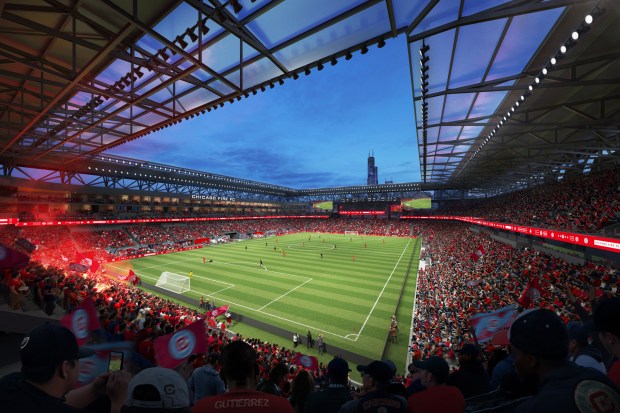The Chicago Fire unveiled detailed renderings of their proposed privately funded $650 million open-air soccer stadium Monday, a state-of-the-art facility at The 78 in the South Loop meant to look like it has been part of the city’s sports landscape for a century.
Situated along the Chicago River, the intimate 22,000-seat, red brick stadium features a natural grass pitch, a steel roof and a plethora of premium options to go with traditional supporter sections and general admission seating.
Designed by architectural firm Gensler, the stadium is seeking to provide the Fire with a “world-class home” and catalyze a Wrigleyville-like development at the mostly vacant 62-acre site south of Roosevelt Road. It purposely evokes a similar vintage to the Cubs longtime home.
“We’ve been involved in design since January, really trying to come up with a vision that aligned with what the team was hoping to do: establish a timelessness in that design that made it feel like a building that had been there a long time, that will be there a long time,” said Kirk Funkhouser, who oversees sports facility design and development out of Gensler’s Austin office.
The new stadium is scheduled to break ground as early as this fall, pending approval from the city, with a target completion date ahead of the 2028 MLS regular season. The Fire currently play at a rarely filled Soldier Field on a newly signed three-year lease extension.
Related Midwest, which is developing The 78, acquired the former rail yard bordered by Roosevelt Road, Clark Street and a half-mile stretch of riverfront south of downtown Chicago, in 2016. The ambitious plan from the outset was to create a sprawling residential, retail and commercial development that would become the city’s 78th neighborhood.
Last year, the White Sox proposed a new publicly funded ballpark at The 78, but Springfield lawmakers balked at the idea of contributing a reported $1 billion to build it. The team has not given up on moving in, but building the Fire’s new stadium is now job one for the developer, the soccer team and the city.
Gensler, which is designing the master plan for The 78, also had a hand in the conceptual White Sox ballpark. The firm has previously designed MLS stadiums in Austin and Los Angeles.
The Fire stadium would be built on nine acres at the north end of the site, with riverfront access for game and event days.
There will be about 2,000 parking spots available at The 78. Fans also can ride the CTA to the stadium; there’s a nearby “L” station and multiple bus lines. Taking a water taxi is a possibility as well.
Dave Baldwin, the Fire’s president of business operations, said the stadium would be busy throughout the year, with about 20 Fire soccer matches and a dozen major events each year, including concerts
In addition to admission revenues, the Fire intends to sell stadium naming rights, which Baldwin said should fetch in the ballpark of $10 million per year.
“We’ve already received outreach from several Fortune 500 companies that have called to inquire,” Baldwin said. “So we’ll be very selective who we partner with, but we’re excited for that opportunity.”



